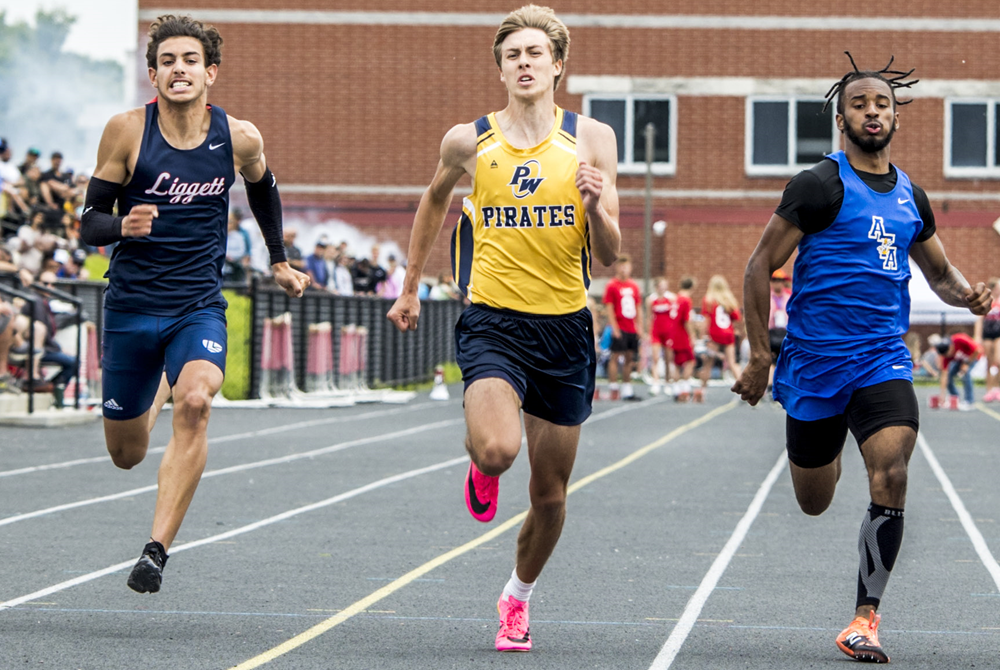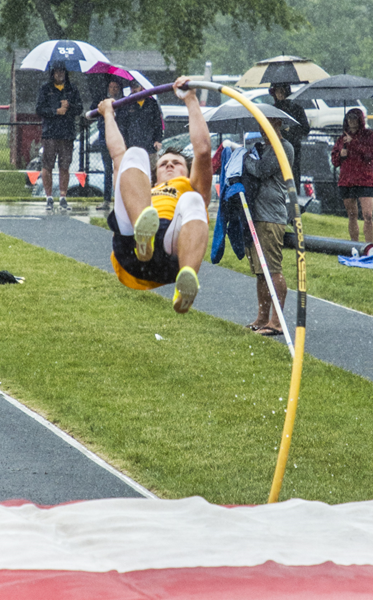
Casting Lines for Future Tournaments
August 12, 2016
By Jack Roberts
MHSAA Executive Director
The MHSAA is best known to the public for the tournaments it conducts to conclude the fall, winter and spring seasons each school year.
These tournaments, the first and largest program of the MHSAA, have survived the Vietnam War, the Korean conflict and two World Wars. They have survived the technology bubble, the housing collapse, the energy crisis and the Great Depression.
MHSAA tournaments existed at the dawn of aviation and at the time of our nation’s lunar landing. Popes, presidents and governors have changed and changed again and again, and MHSAA tournaments roll on year after year.
But the sense of tradition and permanence and inevitability of MHSAA tournaments doesn’t dissuade us from asking questions about our tournaments, even some of the most basic questions. Here are two.
Question #1
I have long been and will always be an advocate for a Ryder Cup format for the MHSAA Golf Finals, and a team tennis approach to the MHSAA Tennis Finals; but 90 years of tradition is hard to overcome. Might this be a more exciting format? Could it be co-ed? Could it reverse the decline in boys tennis participation, and increase girls golf participation? Wouldn’t it be fun to try?
Periodically, the International Olympic Committee requires each of the designated Olympic sports to defend its status, to state its case why the sport should remain a part of the Olympic program. Then, after a series or votes that retain one sport at a time, the IOC drops the sport that makes the weakest case. It does so to make room for one of the previously unlisted sports that makes the best case for inclusion.
This would appear to keep the existing Olympic sports on their toes, and to keep the Olympic movement fresh and reflective of modern trends in sports.
While I would not enjoy the controversy, I can see the potential for some positive results if the MHSAA were to invoke the same policy for determining the 14 tournaments it will provide for girls and the 14 for boys.
This might cause us to consider more deeply what a high school sport should look like, or at least what an MHSAA tournament sport should stand for.
On the one hand, we might be inclined to drop tournaments for those sports that involve mostly non-faculty coaches and non-school venues, or require cooperative programs to generate enough participants to support a team, or resort almost entirely to non-school funding, or cater to individuals more than teams.
Or perhaps this process would cause policymakers to forget traditional thinking and ask: “In this day and age, should we shake off traditional notions of sport and consider more where modern kids are coming from?” That might mean fewer team sports and more individual sports, more “extreme” sports like snowboarding and skateboarding, and more lifetime sports, meaning not just golf and tennis and running sports, but also fishing and even shooting sports.
Currently, MHSAA policy states that the MHSAA will consider sponsorship of a tournament series for any sport which 64 member schools conduct on an interscholastic basis as a result of action by the governing boards of those schools.
Should the only question be how many schools sponsor a sport, or must an activity also have certain qualities and/or avoid certain “defects?” What should an MHSAA tournament sport look like and stand for?
Question #2
Bristling from criticism that his association is a money-grabbing exploiter of children, my counterpart in another state said, “If we were running our programs just to make money, we would do very many things very differently.” I knew exactly what he meant.
Because we care about the health and welfare of students, because we mean what we say that the athletic program needs to maximize the ways it enhances the school experience while minimizing academic conflicts, and because we try to model our claim that no sport is a minor sport when it comes to its potential to teach young people life lessons, we operate our programs in ways that make promoters, marketers and business entrepreneurs laugh, cry or cringe.
If money were the only object, we would seed and select sites to assure the teams that attracted the most spectators had the best chance to advance in our tournaments, regardless of the travel for any team or its fan base. If money were the only object, we would never schedule two tournaments to overlap and compete for public attention, much less tolerate three or four overlapping events. If money were the only object, we would allow signage like NASCAR events and promotions like minor league baseball games.
Those approaches to event sponsorship may not be all wrong; they’re just not all right for us. And we will live with the consequences of our belief system.
During a typical school year, more than 20 percent of the MHSAA’s 2,097 District, Regional and Final tournaments lose money. Not a single site in golf, skiing or tennis makes a single penny. In no sport did every District, Regional and Final site have revenue in excess of direct expenses.
In fact, in only three sports – boys and girls basketball and football – is revenue so much greater than direct expenses overall that it helps to pay for all the other tournaments in which the MHSAA invests.
That’s right: invests. When we present our budget to our board, we talk about the MHSAA’s investment in providing tournament opportunities in all those sports and all those places that cannot sustain the cost of those events on their own. How much is this investment worth to students, schools and society?
These two are core questions that require our focus far in advance of talk about scheduling, site selection, seeding and the myriad matters that too often hijack our time and attention.

Smith Sets Tone as Multi-Talented Pewamo-Westphalia Ascends Again
By
Dean Holzwarth
Special for MHSAA.com
June 1, 2024
KENT CITY – Trevor Smith set the tone early for the Pewamo-Westphalia boys track & field team Saturday at Kent City.
The junior sprinter earned a narrow win in the 100 to collect early points that would prove beneficial in the Pirates’ pursuit of their latest Lower Peninsula Division 3 championship.
“It was a big win right away in the beginning, and it helped put us in a good position,” Smith said. “It was a big emotional shift, and it was unreal.
“I didn’t really expect it, but it was a big help toward our team with points. I just missed winning last year, so to come back and win it meant a lot.”
Pewamo-Westphalia kept its early advantage throughout and hung on in the end to capture the title. The Pirates, last year’s runners-up, recorded 49 points to clip second-place Clare by four points. Detroit Edison was third with 32 points.
P-W senior Gavin Nurenberg repeated in the shot put (60-02), while senior Collin Farmer added a pair of top-4 finishes in the distance events.
“Our boys had a really nice season, but this was always the focus from Day 1,” Pirates coach Scott Werner said. “We felt we had the pieces in place when we got out of Regionals, and we were just excited to attack the day.
“We are the type of program where we are good in quite a few events. We don't rely on one person. We set the tone early with unexpected points in the 3,200 relay, and it built from there.”
 Farmer finished runner-up in the 3,200 and fourth in the 1,600.
Farmer finished runner-up in the 3,200 and fourth in the 1,600.
“There are not a lot of teams that have good guys in the field, sprints and distance, so I think that brings a lot of peace to the team,” Farmer said. “We knew that we could trust each other, and not one person had to take control.”
Senior Dalton Brown also provided a lift with a personal record en route to a third-place finish in the shot put.
“I challenged each of the separate groups to go out and score a minimum of 15 points,” Werner said. “We had a plan and an approach for every single event, and they trusted the process and executed at the highest level. I’m proud of them.”
Clare made a late push with a strong showing in the relays, while also receiving a boost from senior Brad White. He cruised to a win in the 800 with a new personal-best time and also was part of the winning 1,600 relay.
“Honestly, I didn't expect this,” White said. “I came into today pressure-free. I’ve already accomplished everything I could ever want in a season, and I'm just as happy as I can be to come out here and do something special, especially in my last high school race. I’m proud of my team and my PR.”
North Muskegon senior Jerry Wiegers repeated in the 400 by edging Geoffrey McBurrow of Detroit Edison. Wiegers also won the 200.
“There was a lot of pressure (to repeat), and I was worried on the whole ride here that I was going to screw up and I was going to have to hand the title to someone else,” Wiegers said. “But when I finally passed the finish line and I won, I was like, ‘I did this again, in my final year in high school.’ It was a good way to cap off my career.”
Coloma senior Boden Genovese (1,600) and Grayling senior Drew Moore (3,200) won the distance races, and Napoleon senior Holden Van Poppel (110) and Elk Rapids junior Max Ward (300) were hurdles champions. Standish-Sterling (400), Edison (800) and Traverse City St. Francis (3,200) also won relays. Lawton junior Mason Mayne (discus), Ovid-Elsie junior Tryce Tokar (pole vault) and Clare sophomore Conan Weeks (long jump) were other field event winners. Grosse Pointe Woods University Liggett senior Jake Juip (100 and 200), Montague junior Wyatt Fairchild (400) and Perry senior Alec Chapman (shot put) won the adaptive event championships.
PHOTOS (Top) Pewamo-Westphalia's Trevor Smith, center, edges Dearborn Advanced Technology's Cobey Cureton and University Liggett's Santino Cicarella, among others, in the 100 on Saturday. (Middle) Ovid-Elsie's Tryce Tokar attempts a vault amid the rainy conditions. (Click for more from Jamie McNinch/RunMichigan.com.)

